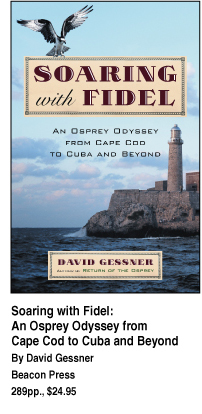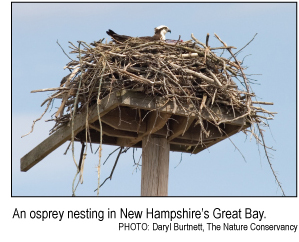|
 Book Review Book Review
Soaring with Fidel
By Lee Bumsted
[printer friendly version]
“I felt lucky to have stumbled
on this particular bird as my obsession,” writes David Gessner
in Soaring with Fidel: An Osprey Odyssey from Cape Cod to
Cuba and Beyond. This obsession leads him to follow the osprey’s
lengthy migratory path one autumn. His journey turns out to be
as much about getting to know osprey people as it is about studying
the birds themselves.
Gessner had observed nesting
pairs of ospreys near his home on Cape Cod and written Return
of the Osprey: A Season of Flight and Wonder a few years
before. This time, he decides he’ll visit prime viewing
spots on the osprey migration route along the eastern seaboard
of the United States. He also gets in touch with a Cuban scientist,
Freddy Santana, who has discovered that ospreys migrate in flocks
along the mountain ridges of southeastern Cuba. The chance to
see them soaring in groups is irresistible, so he jumps at Santana’s
invitation to visit, despite the difficulties of traveling between
Cuba and the United States.
Coincidentally, a few ospreys
are nesting on Cape Cod and nearby Martha’s Vineyard with
radio transmitters the same season the author undertakes his
personal migration, and their locations are posted on a Web site.
Gessner nicknames one of the radio-tagged birds Fidel. He hopes
to be present if Fidel flies over La Gran Piedra near Santiago,
Cuba. Freddy Santana makes Gessner welcome on this mountaintop
observation point. While he doesn’t approach Santana’s
record of spotting 607 ospreys in one day, he nevertheless becomes
absorbed in his visual hunt.
Despite a certain lack of planning,
or perhaps because of it, Gessner falls in with all kinds of
ornithologists and amateur observers. Serendipity and the kindness
of strangers are key to his adventures. Santana is just one of
the many members of the osprey “tribe” who invite Gessner
to meals, set him up in cabins overlooking salt marshes, take
him to productive watch sites and generously share their knowledge
and contacts. Gessner spends an afternoon on Long Island with
a couple of dozen virtual birders who have been glued to Web
cam coverage of an active osprey nest. Young interns at the Cape
May Bird Observatory in New Jersey offer him a pasta dinner and
a couch to sleep on before an early morning counting birds. He
is clearly fascinated by these people whose lives are intertwined
with those of ospreys.
 Gessner
is also quite taken with the birds themselves. “Dives are
what osprey watchers live for, and this one was something, a
brilliant ballet move,” he writes. “Backlit by the
sun, its feathers ruffled and wet from an earlier dive, the bird
looked enormous. It hovered in front of us, readying, the wings
beating fast, 50 feet above the surf. Then the plunge down...gaining
speed and then kicking its legs back right before striking the
water, popping a wheelie, hitting hard, splashing the surface.
It came up empty once, twice, shaking itself like a dog. But
on the third try it rose clutching a fish in its talons, spraying
down a silver-lit waterfall.” Gessner
is also quite taken with the birds themselves. “Dives are
what osprey watchers live for, and this one was something, a
brilliant ballet move,” he writes. “Backlit by the
sun, its feathers ruffled and wet from an earlier dive, the bird
looked enormous. It hovered in front of us, readying, the wings
beating fast, 50 feet above the surf. Then the plunge down...gaining
speed and then kicking its legs back right before striking the
water, popping a wheelie, hitting hard, splashing the surface.
It came up empty once, twice, shaking itself like a dog. But
on the third try it rose clutching a fish in its talons, spraying
down a silver-lit waterfall.”
While Soaring with Fidel
is primarily an eloquent appreciation of ospreys and the people
who watch them, Gessner does provide insight into osprey migration
practices. He quizzes Keith Bildstein, the director of conservation
science at Pennsylvania’s Hawk Mountain, during his visit
there. Bildstein explains that migration is driven by the availability
of fish near the surface of the water, not the weather per se.
Ospreys soar using thermal and mountain updrafts to efficiently
cover the thousands of miles between their nesting and wintering
grounds, which can be as far away as South America. As Bildstein
tells Gessner: “They are predisposed to migration because
their manner of transportation is one of the most effective ways
of moving, not only over long distances but over long distances
in short periods of time. So they can move from one good place
to another good place and they can do it fast.”
Although he has moved south himself
to take a position teaching creative writing at the University
of North Carolina at Wilmington, Gessner brings his “osprey
odyssey” full circle by traveling back to Cape Cod and Martha’s
Vineyard the following spring. He hopes to catch sight of Fidel
and watch the nesting season, and another migratory cycle, begin
again.
Lee Bumsted writes on conservation
and outdoor recreation topics from South Portland, Maine.
|
![]()
